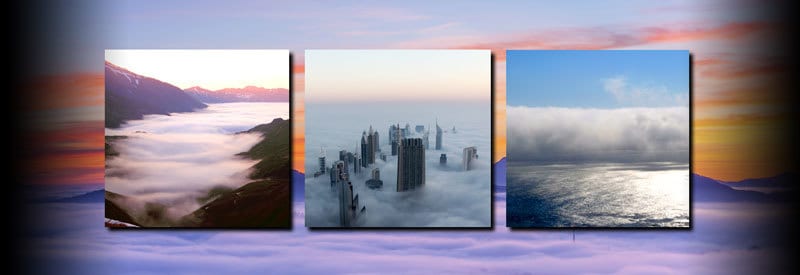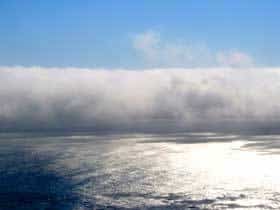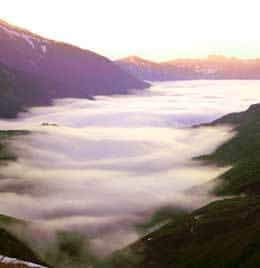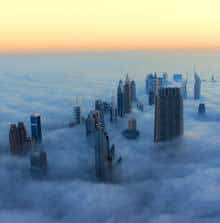Defining Fog And Mist – And How They Differ From Each Other

Most readers will be familiar with or have even personally experienced fog or mist in some shape or form. Although they appear almost identical, they have small but very significant differences.
Fog occurs when visibility is less than 1 km or 0.62 miles, while mist occurs when visibility exceeds 1 km or 0.62 miles, visually making fog a much denser event. Fog is also defined as a cloud forming at ground level, while mist occurs when warm, moist air comes in contact with a cold surface.
People living in coastal regions, near large bodies of water, or in areas regularly experiencing temperature inversion on a regular basis will be very familiar with the occurrence of fog or mist.
Both are very common occurrences, and most of the time, it is hard to tell the difference between these two weather phenomena. There are some slight but significant differences, though, which will be explored in more detail in this post.
What Is Fog?
As with any other weather phenomenon discussed, we first need to define what precisely fog and mist are before continuing to discuss each one in more detail.
What Is Fog?

An event is classified as fog when visibility is less than 1km (0.62 miles). Fog can be defined as a cloud that forms close to or at ground level, consisting of small water droplets suspended in the air. The same processes responsible for cloud formation higher in the atmosphere apply to fog at ground level.
Fog is a visible occurrence and can be seen from a distance as a bank of clouds at ground level. Inside a cloud of fog, the visibility of your surroundings is affected, not dissimilar to looking at them through a veil.
It is this characteristic of fog to limit visibility with varying degrees that makes it so dangerous. Although an area can formally be classified as experiencing fog when visibility is less than 1 kilometer (0.6 miles), it can be limited to just a few meters in extreme conditions.
Not being able to see more than a couple of meters ahead when traveling in any form of transport, especially motor vehicles, can be deadly. It is not uncommon for regions frequently experiencing fog to have fog warnings widely broadcasted and displayed.
What Causes Fog?
As already mentioned, fog is nothing more than a cloud that forms close to or at ground level. This means the various processes through which clouds higher in the air are formed are also responsible for the formation of fog.
Warm moist air cools down until condensation takes place and small water droplets are formed near the surface of the Earth, resulting in fog.
The best way to understand the various ways in which fog is formed is to examine the different types of fog, classified according to the processes through which they are formed:
Types Of Fog
1) Advection Fog

Advection fog forms when moist air moves over a cold surface, for example, the ocean or a snow-covered area. (Advection means the horizontal movement of air ) As a result, the air rapidly cools down, condensates, and fog forms near the surface of the ground.
This type of fog is commonly found in coastal regions, where moist air is blown over the cold ocean waters. Often, the wind blows the fog inland, affecting coastal cities like San Francisco in the United States, Birmingham in the UK, and the harbor area in Hong Kong.
2) Radiation Fog
This short-lived type of fog usually occurs during the early evenings, with calm and clear skies. The ground loses heat quickly due to thermal radiation, and as the air close to the ground cools down past dew point, condensation takes place, and fog forms.
As mentioned, the fog does not last very long and is quickly dissipates after sunrise as the surface starts to warm up.
3) Evaporation Fog
Evaporation fog (also called steam fog) occurs when cold air moves over a body of warmer water. The warm moist air directly above the surface water comes in contact with the colder air, cools down as the two combine and condensation takes place, causing fog to form.
This type of fog is often seen over confined bodies of water. The layer of fog hanging over swamps, large and smaller lakes, and sometimes even swimming pools are all great examples of evaporation fog.
4) Upslope Fog
Some weather events are directly influenced or caused by a region's topography. Upslope fog (also called hill fog) is one such case, as the name already suggests.
Air containing a fair amount of moisture gets blown against the sides of a raised terrain (e.g. a hill or mountain slope). It starts to rise against the incline and cools down as it increases in altitude. As it cools down, condensation takes place, and fog forms against the slopes.
5) Valley Fog

Another type of fog that is the direct result of the topography of a region is valley fog. As the name suggests, this form of fog occurs in valleys and similar indentations on the surface of the earth, like basins and hollows.
As a type of radiation fog, especially after a period of rainfall when the air is moist, the ground at the bottom of the valley cools down when the skies clear up. It cools down the moist air above it, which condensates and forms fog in the same manner as radiation fog.
But this cold, moist air is trapped and accumulates between the slopes of a hill or mountain on the sides and lighter, warmer air (a form of temperature inversion) on top. It results in a thick fog that can last for days, as opposed to the fleeting nature of radiation fog.
Other forms of fog do exist and are listed in other posts but occur to a lesser extent, and most can be classified under one of the types of fog mentioned in this section.
The Difference Between Fog And Mist
What exactly fog is, how it forms, and the different types of fog - all should be very clear by now. Still, at this point, one will struggle to tell the difference between fog and mist.
The two terms are used interchangeably to describe conditions that resemble both phenomena, as they have a lot in common and in many ways, are indistinguishable from each other.
As much as they look and act alike, there are some fundamental differences between mist and fog, in both the way they formed, as well as their characteristics. Before examining these differences, we will need a more precise definition of what exactly mist is:
What Is Mist?

An event is classified as mist when visibility is more than 1km (0.62 miles). Mist is the occurrence of small droplets of water suspended in the atmosphere, which is the result of the sudden cooling of warm, moist air when it comes in contact with a cold surface.
What Differentiates Fog From Mist?
As already stated, fog and mist differ from each other not just in the way they are formed but also in their appearance. By briefly looking at each difference, you will get a much better understanding of how they can be distinguished from one another:
1) Visibility
The one key difference everyone agrees on is the contrast in density between fog and mist. When visibility is less than 1 kilometer (0.6 miles), the phenomenon is called fog. When it is more than 1 kilometer, it is called mist.
In short, fog is much thicker than mist. For many observers, this is the only real difference between the two. But they differ from each other in more ways than just their density.
2) Formation and Duration
Generally, fog takes longer to form and develop since it is nothing more than a cloud at ground-level and subject to all the processes that form clouds higher up in the atmosphere.
Mist is a much more sudden event and can rapidly appear when warm moist air comes in contact with a cold surface. The warm moist air you exhale on a cold day, and the air coming into contact with volcanic ash are just two examples of rapid-appearing mist.

Sometimes, though, there is an overlap between the two. A type of radiation fog is one occurrence that can be seen as either fog or mist under the right conditions.
As the ground cools down during the evening due to thermal radiation, it causes the air above it to cool down rapidly as well. Especially at the coast, with the air already saturated with moisture, condensation takes place quickly, and a layer of fog is formed.
During the mornings, the heat from the sun causes the fog to dissipate almost as quickly as it developed the previous night. In this case, the sudden appearance and quick dissipation of fog that is so characteristic of mist allow for this event to be called either fog or mist.
3) Resilience And Dissipation
Partly due to its density, fog tends to be more resilient to wind, sunlight, and other variables that contribute to its dissipation. This resilience allows it to stay in place longer over the areas it developed. One example is valley fog that can persist and last for days.
Mist, on the other hand, is burned away or dissipates very quickly. The mist that forms near the coast overnight evaporates in a few hours after sunrise, and it's a matter of seconds before the condensation from our breaths disappears in the cold air.
To be honest, the differences just mentioned in this section show some "technical differences" between fog and mist but do not display any stark contrasts. For any observer, just looking at these phenomena after they formed, it will be tough to tell them apart.
Conclusion
After reading this post, you will be forgiven for being even more confused. Trying to explain such closely related terms like fog and mist is no easy task. Understanding these subtle similarities and differences can be even more difficult.
By clearly labeling and describing each phenomenon, explaining how it is formed, and laying out the differences between fog and mist as logically as possible, you will now be able to have a better understanding of the definition and formation of each phenomenon.
Never miss out again when another interesting and helpful article is released and stay updated, while also receiving helpful tips & information by simply clicking on this link .
Until next time, keep your eye on the weather!
